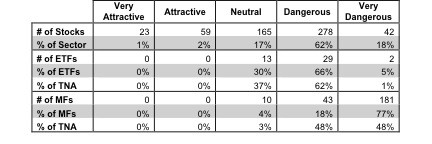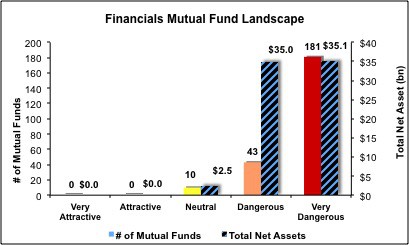The Financials sector ranks tenth out of the ten sectors as detailed in my Sector Rankings for ETFs and Mutual Funds report. It gets my Dangerous rating, which is based on aggregation of ratings of 44 ETFs and 234 mutual funds in the Financials sector as of July 10, 2013. Prior reports on the best & worst ETFs and mutual funds in every sector are here.
Figures 1 and 2 show the five best and worst-rated ETFs and mutual funds in the sector. Not all Financial sector ETFs and mutual funds are created the same. The number of holdings varies widely (from 20 to 535), which creates drastically different investment implications and ratings. The best ETFs and mutual funds allocate more value to Attractive-or-better-rated stocks than the worst ETFs and mutual funds, which allocate too much value to Neutral-or-worse-rated stocks.
To identify the best and avoid the worst ETFs and mutual funds within the Financials sector, investors need a predictive rating based on (1) stocks ratings of the holdings and (2) the all-in expenses of each ETF and mutual fund. Investors need not rely on backward-looking ratings. My fund rating methodology is detailed here.
Investors should not buy any Financials ETFs or mutual funds because none get an Attractive-or-better rating. If you must have exposure to this sector, you should buy a basket of Attractive-or-better rated stocks and avoid paying undeserved fund fees. Active management has a long history of not paying off.
Get my ratings on all ETFs and mutual funds in this sector on my free mutual fund and ETF screener.
Figure 1: ETFs with the Best & Worst Ratings – Top 5
* Best ETFs exclude ETFs with TNAs less than $100 million for inadequate liquidity.
Sources: New Constructs, LLC and company filings
Four ETFs are excluded from Figure 1 because their total net assets (TNA) are below $100 million and do not meet our liquidity standards.
Figure 2: Mutual Funds with the Best & Worst Ratings – Top 5
* Best mutual funds exclude funds with TNAs less than $100 million for inadequate liquidity.
Sources: New Constructs, LLC and company filings
ICON Financial Fund (ICFSX) is excluded from Figure 2 because its total net assets (TNA) are below $100 million and do not meet our liquidity standards.
First Trust Financials AlphaDEX Fund (FXO) is my top-rated Financials ETF and Davis Financial Fund (DVFYX) is my top-rated Financials mutual fund. Both earn my Neutral rating.
iShares Industrial/Office Real Estate Capped ETF (FNIO) is my worst-rated Financials ETF and Rydex Series Funds: Real Estate Fund (RYREX) is my worst-rated Financials mutual fund. Both earn my Very Dangerous rating.
Figure 3 shows that 82 out of the 567 stocks (over 3% of the market value) in Financials ETFs and mutual funds get an Attractive-or-better rating. While Dangerous-or-worse stocks outnumber attractive ones by nearly 4 to 1, you would think at least one of the 44 ETFs or 234 mutual funds in the sector would be able to put together an Attractive portfolio, but that is not the case.
The takeaways are: mutual fund managers allocate too much capital to low-quality stocks and Financials ETFs hold poor quality stocks.
Sources: New Constructs, LLC and company filings
As detailed in “Cheap Funds Dupe Investors”, the fund industry offers many cheap funds but very few funds with high-quality stocks, or with what I call good portfolio management.
Investors need to tread carefully when considering Financials ETFs and mutual funds, as 31 out of 44 ETFs (63% of net assets) and 224 out of 234 mutual funds (96% of net assets) in the Financials sector earn a Dangerous-or-worse rating.
Goldman Sachs (GS) is one of my favorite stocks held by Financials ETFs and mutual funds and earns my Very Attractive rating. GS also makes it onto July’s Most Attractive stocks report. GS has recovered well from the crisis of 2008, earning an 11% return on invested capital (ROIC) in 2012. Non-recurring losses, such as a $450 million provision for litigation and regulatory expenses, caused GAAP earnings for GS to be $1.1 billion less than its net operating profit after tax (NOPAT) for 2012.
Possibly due to these misleadingly low earnings (and also possibly due to the negative association of GS with the financial crisis) GS is trading at a very cheap price currently. At its current valuation of ~$156.94/share, GS has a price to economic book value ratio of only 0.8, implying a permanent 20% decline in NOPAT. While competitors like Morgan Stanley (MS) are priced for significant growth, GS is available to investors at a discount.
Hudson City Bancorp (HCBK) is one of my least favorite stocks held by Financials ETFs and mutual funds and earns my Very Dangerous rating. HCBK has only grown NOPAT by 4% compounded annually over the past decade. It has a 4th quintile ROIC of 6% and negative economic earnings. On their own, these below-average fundamentals aren’t enough to make a stock Very Dangerous, but HCBK also has an extremely high valuation. To justify its current share price of ~$9.72, HCBK would need to grow NOPAT by 10% compounded annually for nine years. Essentially, investors in HCBK are betting its next decade will bring more than double the growth of the last one. Other stocks in this sector offer stronger fundamentals at much cheaper valuations.
580 stocks of the 3000+ I cover are classified as Financials stocks, but due to style drift, Financials ETFs and mutual funds hold 567 stocks.
Figures 4 and 5 show the rating landscape of all Financials ETFs and mutual funds.
My Sector Rankings for ETFs and Mutual Funds report ranks all sectors and highlights those that offer the best investments.
Figure 4: Separating the Best ETFs From the Worst ETFs
Sources: New Constructs, LLC and company filings
Figure 5: Separating the Best Mutual Funds From the Worst Mutual Funds
Sources: New Constructs, LLC and company filings
Review my full list of ratings and rankings along with reports on all 44 ETFs and 234 mutual funds in the Financials sector.
Sam McBride contributed to this report.
Disclosure: David Trainer and Sam McBride receive no compensation to write about any specific stock, sector or theme.





